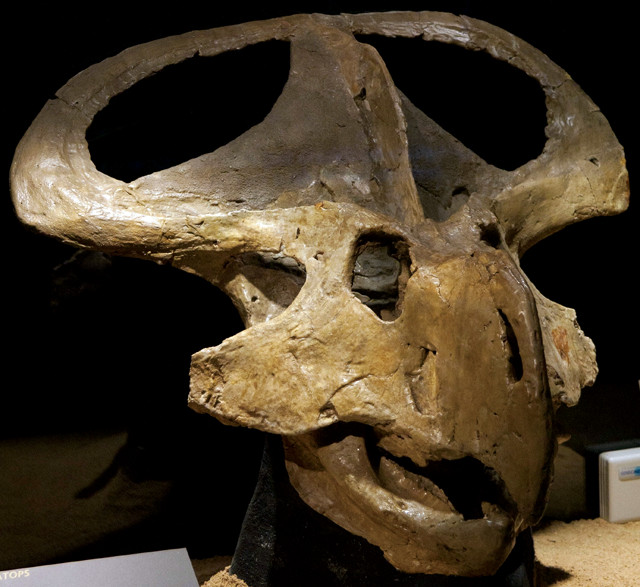
by Mary Caperton Morton Wednesday, September 2, 2015

A new study of 29 Protoceratops specimens suggests that males and females cannot be distinguished based on their skulls. Credit: Karen, CC BY 2.0.
Modern birds like cardinals and peacocks offer some of the most dramatic examples of sexual dimorphism on Earth, with males and females varying in size and/or displaying different plumage, among other differences. But whether the two sexes of birds’ dinosaur ancestors also possessed different physical characteristics has long been debated. Now, in a new study, scientists using state-of-the-art measuring techniques to look at Protoceratops — a frilled, horned relative of Triceratops that’s found abundantly in the fossil record — are questioning past notions about whether the sex of specimens can be distinguished based on their fossils.
In 1940, one of the first studies to investigate sexual dimorphism in dinosaurs found, from a sample of 10 Protoceratops skulls, that males had a broader frill and a taller nasal horn than females. In 1976, paleontologist Peter Dodson of the University of Pennsylvania used an early computer to study 24 additional skulls and also found that males differed from females and juveniles. “At the time, it was a groundbreaking study,” says Dodson, who was not involved in the new study. “It was the first time somebody had looked at a population of dinosaurs — not a single specimen or a handful, but two dozen.”
However, Dodson admits that his study was “crude” by today’s standards. “That was really the Wright Brothers-era of computing. Now we have geometric morphometrics, which is a very powerful tool for collecting data,” he says.
The latest research analyzed 29 Protoceratops skulls — including some of the same specimens that Dodson studied — using geometric morphometrics. The technique allows researchers to “capture the overall geometry … of biological structures,” and is more accurate than relying on simple linear measurements of skull length or height, for example, says Leonardo Maiorino, a paleontologist at Roma Tre University in Italy and lead author of the new study published in PLOS ONE. Maiorino and his colleagues “digitized the shape of 29 skulls in top and side views, based on photographs, to explore the geometry that represents the skull shape,” he says.
The team’s detailed look at the skulls found no clear separation between males and females. “We noted a broad overlap between skulls [deemed] males and females, suggesting a similar cranial shape,” Maiorino says. “No matter how we plotted or analyzed the data, we were not able to find a clear, statistically significant difference between males and females.”
Dodson says he is not entirely convinced yet that Maiorino and his colleagues have disproved the existing theories about sexual dimorphism in Protoceratops. “They may be right and I may be wrong, but I think the differences [between the sexes] may be more subtle than they’re recognizing.” Additional statistical tests beyond those conducted in the study, such as a canonical variate analysis, could be used to more clearly determine whether the two sexes are statistically different, he says.
A number of previous studies have suggested that other species of ceratopsid dinosaurs — such as Triceratops — may be sexually dimorphic, but nobody has been able to show that the differences between males and females are strong enough to definitively sex dinosaurs based on their fossils, says Andrew Farke, a paleontologist at the Raymond M. Alf Museum of Paleontology in Claremont, Calif., and a co-author of the new study.
“That’s not to say there aren’t differences between males and females, but the samples we have might not be sufficient to show it,” he says. “Many species of dinosaur may have differentiated between males and females by using characteristics that don’t fossilize, such as color or vocalizations or behaviors.”
© 2008-2021. All rights reserved. Any copying, redistribution or retransmission of any of the contents of this service without the expressed written permission of the American Geosciences Institute is expressly prohibited. Click here for all copyright requests.